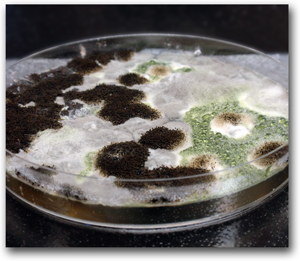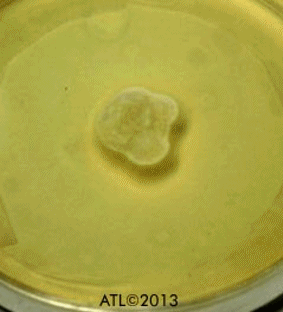Mold can form when tiny free-floating reproductive particles, called spores, come in contact with water and virtually any organic material.
Spores that dwell for 24-48 hours under these simple conditions can become entrenched, then grow quickly into macrostructures that are visible to the naked eye. Visible mold is often accompanied by foul, musty odors.
While mold and other fungi play an essential role in nutrient recycling in nature, they can be a real menace when they migrate into homes and the workplace. Due in part to a growing public awareness and concern over the matter of indoor mold, especially with respect to children, the Centers for Disease Control and Prevention (CDC) commissioned a large study to investigate the relationship between dampness, mold, and associated adverse health outcomes(1). The product of this effort was a comprehensive literary review published in 2004 titled “Damp Indoor Spaces and Health.” The overarching goal of the study was to align the scientific community under common language and provide a useful set of guidelines for improving research and communications between institutions and the public. It is now generally accepted that exposure to mold and other microbes can lead to a host of medical conditions; both physiological and psychological.
Physiological ailments attributed to the proliferation of mold in human dwellings range from slight eye or skin irritation to allergies, asthma, toxicosis, and severe infections in the immunocompromised. In 2007, the Institute of Medicine of the National Academy of Sciences performed a meta-analysis of the literature to quantitatively determine the correlation between indoor mold contamination and adverse health effects. The critical review of 33 studies concluded that damp, indoor mold harboring environments resulted in a 30-50% (positive correlation value of 0.3 – 0.5) increase in the likelihood of adverse respiratory and asthma related health outcomes (2). Other similar analyses have since corroborated these findings (3,4), but to date no causal link between specific molds and their pathological pathways has been established.
Human exposure to mold has also been considered as a cause for a spectrum of negative neurologically-related health problems including delirium, trouble keeping balance, depression, pain syndrome, dementia, movement disorders, and chronic fatigue syndrome (5,6). Findings from a European study published in 2007 suggested a moderate link between indoor dampness and depression, with older individuals, women, and unemployed respondents being disproportionately affected (7). This work was important, because it found that outcomes of depression related to mold were at least in part mediated by individual’s inability to control their environment. Much as is the case with the proliferation of roaches, termites, wasps, rodents, and even rust, just the unsightly presence of mold may be enough to reduce human well-being even if the direct impact to one’s physical health is minimal or non-existent.
So what are the best ways to address the inevitability of being exposed to mold? According to the EPA and the CDC, the most straightforward way to reduce the impact of mold on human life is to control localized moisture or dampness, humidity in the air, and the amount of dead or decaying material on surfaces. However, this is not practical in all facilities or parts of a home since it is impossible to exclude water and organic material from all surfaces. This is true because of one simple fact; many of the household and architectural products we have come to rely on are themselves capable of sustaining fungal growth.
 Materials known to readily support fungal growth primarily include porous surfaces such as clothing, upholstery, drywall, paper products, and leather. These soft materials are capable of retaining large amounts of water and provide spores abundant surface area to establish viable colonies. However, non-porous plastics, wood, and composites have also shown the ability to sustain fungus. Our relentless quest to develop innovative products and control manufacturing costs often leads to the engineering of advanced materials that are prone to fungal attack.
Materials known to readily support fungal growth primarily include porous surfaces such as clothing, upholstery, drywall, paper products, and leather. These soft materials are capable of retaining large amounts of water and provide spores abundant surface area to establish viable colonies. However, non-porous plastics, wood, and composites have also shown the ability to sustain fungus. Our relentless quest to develop innovative products and control manufacturing costs often leads to the engineering of advanced materials that are prone to fungal attack.
The presence of fungus on a non-soiled surface is evidence that the underlying material is being decomposed, which may lead to a loss of structural integrity and material failure. For instance, the fungus A. pullallans can utilize plasticizers used in the industrial manufacturing of polyvinyl chloride (PVC) as sole sources of carbon (8). This study demonstrated that fungal degradation of PVC leads to a significant loss in substratum weight which results in a loss in strength. In a more recent study, it was shown that the decomposition of the polyurethane coating (Impranil) buried in fungi-containing soil resulted in up to a 95% loss in tensile strength (9).
To solve both the public health and material-related costs associated with mold and other fungi, many companies are now engineering advanced materials capable of resisting fungal growth as a means of preventing the spread of mold regardless of environmental spore counts or level of dampness. This additional line of defense requires widespread testing of new products under highly controlled laboratory conditions.
There are currently several available standard methods for testing a material’s ability to resist fungal attack. The most widely used testing methods include ATSM G21, ASTM D5590, ASTM D3273, and AATCC 30 standards. In short, these methods can be divided into two testing paradigms; one that measures the fungal resistance of a material under limited growth conditions and the other which provides conditions that promote optimum growth.
Experiments that test materials for fungal resistance under limited growth conditions are designed to establish whether or not the material can itself be used as a sole source of carbon. This is accomplished by excluding all carbon from testing media while furnishing a source of nitrogen and all other required minerals. Conversely, experiments designed under optimum growth conditions aim to test materials that are augmented with antifungal agents. In optimum growth testing, all required nutrients are included in testing media. Measuring fungal resistance under optimum growth provides the most stringent testing conditions for any material.
Although the body of research remains incomplete, the current knowledge base suggests that the public concern over the proliferation of mold is warranted since so much of our time is spent indoors and the presence of mold can negatively affect psychological health. The link to physical illness remains speculative, except in individuals with compromised immune systems. Businesses and homeowners everywhere have become increasingly conscious of this as they choose materials used in construction and facility operations. Today, several mold resistant materials are available in the market including insulation, wood, drywall, paint, tape, stucco, carpet, caulking, sealants, etc. All of these materials undergo rigorous, highly controlled fungal resistance investigations. While we cannot control incidental water leaks, flooding, and other environmental elements that lead to dampness, we are increasingly capable at preventing the spread of mold indoors.
References
- Human Health Effects Associated with Damp Indoor Environments.” Damp Indoor Spaces and Health.” Washington, DC: The National Academies Press, 2004.
- W. J. Fisk, Q. Lei-Gomez, M. J. Mendell Meta-analyses of the associations of respiratory health effects with dampness and mold in homes, Indoor Air, 17, 284-296, 2007.
- Mark J. Mendell, Anna G. Mirer, Kerry Cheung, My Tong,and Jeroen Douwes “Respiratory and Allergic Health Effects of Dampness, Mold, and Dampness-Related Agents: A Review of the Epidemiologic Evidence” Environ Health Perspect., 119, 748–756, 2011.
- William J Fisk, Ekaterina A Eliseeva, Mark J Mendell “Association of residential dampness and mold with respiratory tract infections and bronchitis: a meta-analysis “Environ Health. 9, 72, 2010.
- L. Empting, “Neurologic and neuropsychiatric syndrome features of mold and mycotoxin exposure,” Toxicology and Industrial Health, 25, 577–581, 2009.
- Brewer, Joseph H., et al. “Detection of Mycotoxins in Patients with Chronic Fatigue Syndrome.” Toxins, 5.4 605-617, 2013.
- Edmond D. Shenassa, Constantine Daskalakis, Allison Liebhaber, Matthias Braubach, and MaryJean Brown “ Dampness and Mold in the Home and Depression: An Examination of Mold-Related Illness and Perceived Control of One’s Home as Possible Depression Pathways” American Journal of Public Health, 10, 1893-1899, 2007.
- Jeremy S. Webb, Marianne Nixon, Ian M. Eastwood, Malcolm Greenhalgh, Geoffrey D. Robson, Pauline S. Handley “Fungal Colonization and Biodeterioration of Plasticized Polyvinyl Chloride” Appl. Environ. Microbiol., 66, 194-3200, 2000.
- Lee Cosgrove, Paula L. McGeechan, Geoff D. Robson, Pauline S. Handley “Fungal Communities Associated with Degradation of Polyester Polyurethane in Soil” Appl. Environ. Microbiol. 73, 5817-5824, 2007

